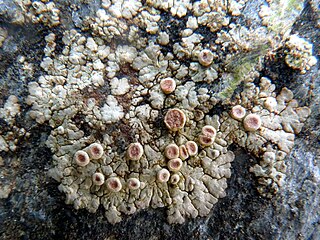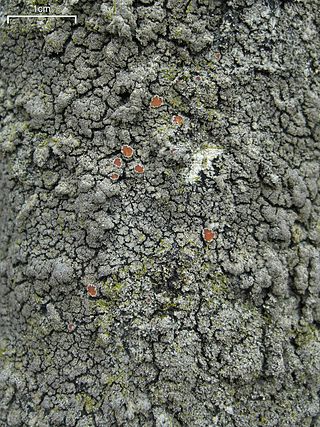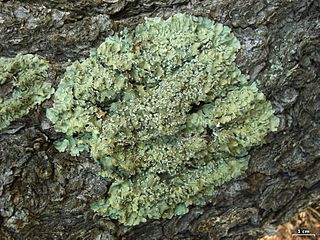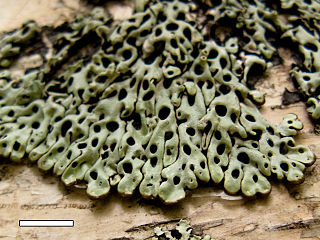
The Pannariaceae are a family of lichens in the order Peltigerales. Species from this family have a widespread distribution, but are especially prevalent in southern temperate regions.

The Sphaerophoraceae are a family of lichenized fungi in the order Lecanorales. Species of this family have a widespread distribution, especially in southern temperate regions. Sphaerophoraceae was circumscribed by mycologist Elias Magnus Fries in 1831.

Sticta is a genus of lichens in the family Peltigeraceae. The genus has a widespread distribution, especially in tropical areas, and includes about 114 species. These lichens have a leafy appearance, and are colored brown or black. Sticta species with cyanobacteria as photobionts can fix nitrogen from the atmosphere, and due to their relative abundance and high turnover, they contribute appreciably to the rainforest ecosystem. They are commonly called spotted felt lichens.

Placopsis is a genus of lichenized fungi in the family Trapeliaceae.
Thalloloma is a genus of lichens in the family Graphidaceae. It contains 20 species.
Metus is a genus of three species of lichenized fungi in the family Cladoniaceae. The genus was circumscribed by lichenologists David John Galloway and Peter Wilfred James in 1987, with Metus conglomeratus as the type species. All three species are found in the Southern Hemisphere.
Stirtoniella is a lichen genus in the family Ramalinaceae. It is a monotypic genus, containing the single species Stirtoniella kelica, a crustose and corticolous lichen originally described from New Zealand in 1873 as a species of Lecidea. The photobiont is an alga of the family Chlorococcaceae. The genus is named after Scottish mycologist James Stirton.

Parmeliella is a genus of lichenized fungi in the family Pannariaceae. It occurs mainly in the tropics and sub-tropics, with species found in Africa, Asia, Australasia and South America. A recent (2020) estimate places 41 species in the genus.

Pannaria is a genus of lichen-forming fungi in the family Pannariaceae. The widespread genus contains an estimated 51 species, found primarily in tropical regions.
Fuscoderma is a genus of lichenized fungi in the family Pannariaceae. It was originally circumscribed as a subgenus of the genus Leioderma by David Galloway and Per Magnus Jørgensen in 1987. The same authors promoted it to generic status a couple of years later in 1989. The New Guinean species F. papuanum was added to the genus in 2002.

Degelia is a genus of lichen-forming fungi in the family Pannariaceae. The genus is named after Swedish lichenologist Gunnar Degelius.
Clathroporina is a genus of lichenized fungi in the family Trichotheliaceae. It was circumscribed by Swiss lichenologist Johannes Müller Argoviensis in 1882.

Flavopunctelia is a genus of foliose lichens in the family Parmeliaceae. The genus contains species that are widespread in temperate and tropical areas. The genus is characterised by broad, yellow-green lobes, point-like (punctiform) pseudocyphellae on the thallus surface, and bifusiform conidia. All species contain usnic acid as a major secondary chemical in the cortex. Flavopunctelia was originally conceived as a subgenus of Punctelia by Hildur Krog in 1982; Mason Hale promoted it to generic status in 1984.

Menegazzia pertransita is a species of foliose lichen in the large lichen family Parmeliaceae. It is found in New Zealand, Australia, and South America. The lichen was first formally described by Scottish physician and bryologist James Stirton in 1877 as Parmelia pertransita. Swedish lichenologist Rolf Santesson transferred it to the genus Menegazzia in 1942.
James Stirton was a Scottish physician and one of Scotland's leading experts on cryptogamic botany. His investigations in bryology and lichenology earned him a world-wide reputation.
Rolueckia is a genus of leaf-dwelling lichens in the family Gomphillaceae. It was circumscribed in 2008 by Thai lichenologists Khwanruan Papong, Achra Thammathaworn, and Kansri Boonpragob. The three species in the genus were formerly part of the Calenia conspersa group, previously part of the genus Calenia. The type species, Rolueckia conspersa, was first described as Thelotrema conspersum by James Stirton in 1879.
Punctelia toxodes is a species of foliose lichen in the family Parmeliaceae. The lichen is a member of the Punctelia rudecta species complex. Found in South Africa, it was first formally described as a new species by English botanist James Stirton in 1878 as Parmelia toxodes. Klaus Kalb and Manuela Götz transferred it to the genus Punctelia in 2007. In his 1878 publication, Stirton did not designate a type specimen, so an epitype was designated in a 2016 publication. This epitype was collected from the Cape Floristic Region of South Africa, on Paarl Mountain at an altitude of 530 m (1,740 ft). The lichen grows on bark and on rocks.
Punctelia subalbicans is a species of foliose lichen in the family Parmeliaceae. It is found in Australia and New Zealand, where it grows on the bark of various tree species.

Flavopunctelia flaventior is a species of foliose lichen in the family Parmeliaceae. It was first formally described as a new species by James Stirton in 1877 as Parmelia flaventior. In 1982, Hildur Krog transferred it to the subgenus Flavopunctelia of her newly circumscribed genus Punctelia, created to contain Parmelia species with punctate (point-like) pseudocyphellae. Mason Hale raised this subgenus to generic status a couple of years later, setting Flavopunctelia flaventior as the type species of the new genus. The lichen is commonly known as the speckled greenshield. Flavopunctelia flaventior occurs in Asia, Europe, East Africa, North America, and South America.
Calycidium is a genus of lichen-forming fungi in the family Sphaerophoraceae. It has two species. It is one of the few lichen genera containing foliose (leafy) species that produce a mazaedium – a powdery mass of spores. Both species occur in Australasia and South America, where they grow on tree bark or on mosses.








